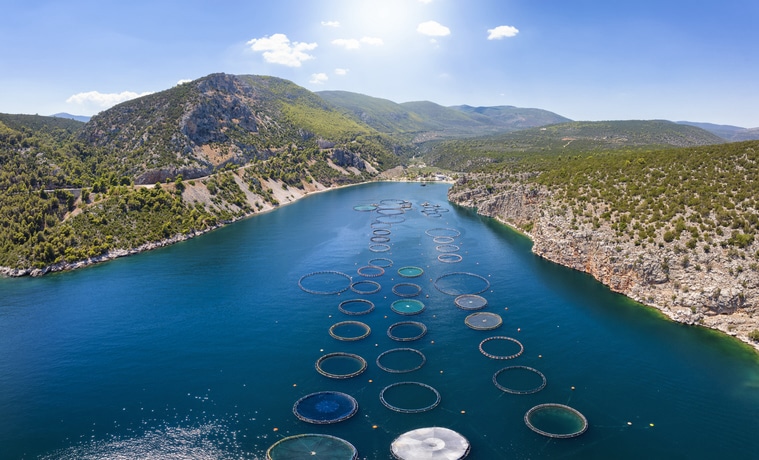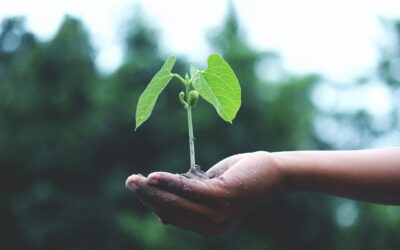This post was originally published on Eco Watch
Quick Key Facts
- Aquaculture is the agricultural practice of cultivating livestocks of aquatic species for human consumption.
- Around half of the fish consumed around the world come from various aquaculture businesses, which cultivate and harvest hundreds of distinct species.
- There are several types of aquaculture operations based on the type of water and infrastructure used.
- Many aquaculture facilities are spread across Asia, whereas the U.S. has relatively few farms.
What Is Aquaculture?
When you think of agriculture, the first images that come to mind might include big red barns full of hay, a flock of fuzzy sheep or an orchard of apple trees. But agriculture isn’t just all the flora, fauna and equipment that puts land-based food to our plates. It can also include everything we hunt and consume under the sea.
Aquaculture is a subsector within the agriculture industry. Humans working in this field cultivate or farm livestocks of aquatic species — anything from sea urchins, crabs and kelp to salmon and tuna — for consumption. Around 580 aquatic species are harvested through aquaculture methods, “accounting for half of the world’s consumed fish,” according to Euronews.
According to the Food and Agriculture Organization of the United Nations (FAO), global aquaculture production in 2020 included 87.5 million tonnes of aquatic animals that mainly went toward human consumption and 35.1 million tonnes of algae, including seaweed for “food and non-food uses.”

What Are the Different Types of Aquaculture?
There are a few ways to categorize the different types of aquaculture facilities.
Marine vs. Freshwater Operations
One way to classify aquaculture operations is by the type of water they use, i.e. water that is salty, not salty (read: freshwater) or brackish (meaning it’s somewhat salty). The most obvious distinction is that the different types of water represent separate ecosystems, which influence which species can be grown.

Marine or saltwater aquaculture operations can cultivate shellfish like mussels, shrimp, oysters or clams, as well as algae, kelp and other fish like salmon, black sea bass and pompano, according to the National Oceanic and Atmospheric Administration (NOAA). The FAO says that brackish water operations are primarily centered around shrimp.
Freshwater facilities, meanwhile, can develop freshwater species like catfish and trout; NOAA says that roughly 70% of U.S. aquaculture is dedicated to freshwater catfish and trout cultivation.
But the type of harvestable species isn’t the only dissimilarity between marine and freshwater aquaculture operations. They also require different types of infrastructure, explains the U.S. Geological Survey.
“Marine fish farming is typically done in net pens in the water or in tanks on land,” the federal agency explains on its website. “Freshwater aquaculture primarily takes place in ponds or other manmade systems.”

A scallops farm in Tongoy Bay, Chile. Maria Valladares / NOAA Photo Library
Natural vs. Artificial Environments
The Aquaculture Stewardship Council, or ASC, says that some aquaculture facilities will utilize the actual environment the aquatic species would naturally be found in, like an ocean or pond, but will be held in an enclosure — like a pen, net or cage — so they cannot escape. But other operations may opt to create an artificial environment, like a tank, onshore that is filled with the type of water the species prefers.
In some onshore aquaculture farms, “the water is used only once (open system), [whereas] in others the water is recycled (closed or recirculation system),” according to the organization.

Where Are Aquaculture Facilities Located?

The vast majority of the world’s aquaculture production — 92% — occurs in Asian countries, according to NOAA. China produces the vast majority of that, but the next four top-producing countries are all also in Asia: India, Indonesia, Vietnam and Bangladesh, respectively in that order, according to Statista.
Although the country consumes a lot of aquaculture products, NOAA says that the U.S. actually imports the vast majority — 84% — of its seafood. Half of that, the agency explains, is from aquaculture facilities. Only 5% of the country’s seafood supply comes from domestic aquaculture operations.

Oyster aquaculture in Oregon. Alex Manderson / Oregon Department of Agriculture
In the U.S., many states have aquaculture industries, but which has the largest might depend on the metric you want to consider. Louisiana, for example, has the largest number of aquaculture farms per the U.S. Department of Agriculture’s latest Census of Aquaculture. But when you look at the value of total products sold listed in the report, Mississippi comes out on top.
The federal government cites projections that the global aquaculture market will rise from its $204 billion value in 2020 to $262 billion before 2027. Other U.S. states are also looking to capitalize on the shift to aquaculture, including Maine, where several significant — and controversial — aquaculture facilities are under development.

Catfish ponds in Louisiana, which vary in color depending upon algae type and quantity. Scott Bauer / USDA
What Are Some Benefits of Aquaculture?
Preserve Wild Stocks
According to the ASC, “some 33% of wild fish stocks have already reached their biological limit because of destructive fishing practices and overfishing,” meaning fishers shouldn’t continue harvesting fish from those areas because the fish can’t replenish themselves. Proponents of aquaculture facilities say cultivating farms of aquatic species reduces pressure on wild stocks, giving them time to repopulate.
NOAA also touts aquaculture for its ability to “restore habitat and replenish wild stocks and rebuild populations of threatened and endangered species.”

Promote Societal Welfare
Hunger and poverty are complex societal problems experienced around the world. NOAA believes that increasing the amount of aquaculture — and thus the amount of farmed aquatic species for human consumption — would help lift people out of poverty and eliminate hunger with nutritious food.
“Leading health experts promote the value of adding seafood to one’s diet, especially for people who are pregnant or nursing and children,” explains NOAA. “Farmed seafood can lead to improved nutrition and food security for many communities.”

What Are Some Problems With Aquaculture?
Relatively Small Jobs Growth
Aquaculture isn’t expected to result in a huge number of jobs. Federal estimates suggest animal production and aquaculture workforce needs will actually shrink by 13.8% in the coming decade.
That appears to be the trend even in states where the economic impact of aquaculture has notably risen. In Maine, for example, the aquaculture industry directly employed 880 people in 2020, according to the Gulf of Maine Research Institute. But the center only expects the industry’s direct employment to rise to around 1,000 positions in the next decade.

Pollution
Anyone with a pet knows that one animal is messy. But multiply one animal by several dozen thousand, and you can have a notable source of pollution on your hands without monitoring and cleaning. According to the U.S. Environmental Protection Agency, aquaculture is tied to a number of pollutants, including fish poop, uneaten fish feed and antibiotics. Nutrient pollution, which can lead to algae blooms, is also a problem from a facility with excess phosphorus, nitrogen and ammonia.

In an open ocean or pond pen, all that pollution doesn’t stay neatly confined with the fish. It floats beyond its boundaries or spills out of its border, fouling the surrounding ecosystem. Land-based systems that have wastewater management systems can avoid pollution spillover.
The aquaculture industry also has a major marine plastic pollution problem, although it’s hard to pin down the severity given the difficulty of ocean pollution monitoring.
“Pathways for aquaculture-related litter… include rough weather, farmer behavior, inadequate access to recycling facilities, low price of consumable plastics and high cost of recycling,” according to a group of European researchers studying plastic pollution in the northeast Atlantic Ocean.
Disease
Excessive pollution and crowded conditions can stress out fish, making them more susceptible to disease. NOAA explains that sick and dead fish in the wild are eaten by predators but that disease-spreading individuals aren’t able to be thinned from the herd as easily in confinement. If an aquaculture facility isn’t diligent in its monitoring, disease can spread within the livestock or even beyond into the wild population.
The post Aquaculture 101: Everything You Need to Know appeared first on EcoWatch.





0 Comments